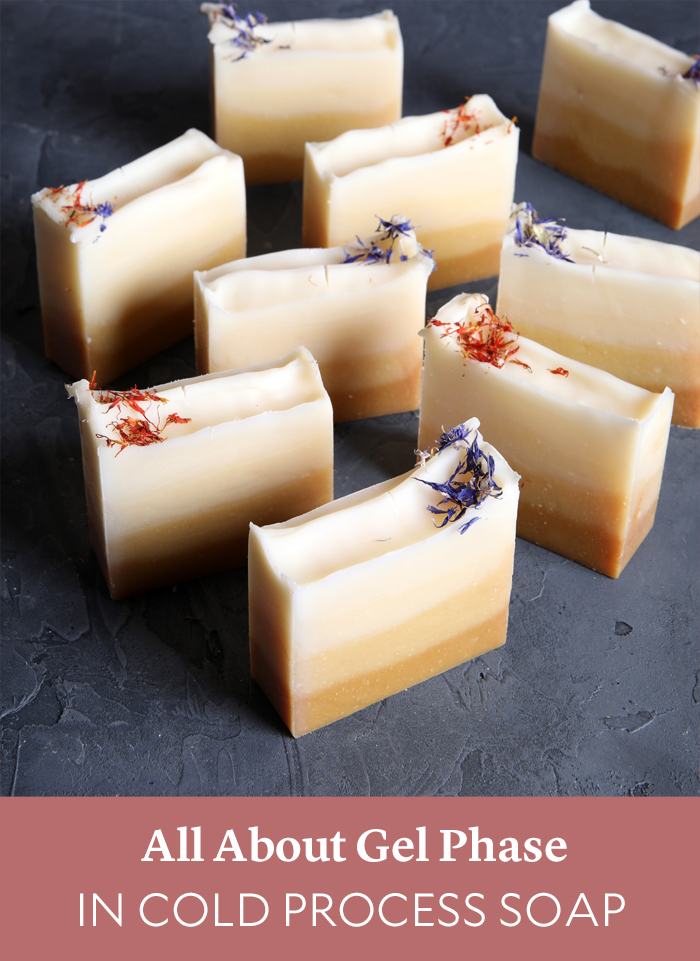
Has your cold process soap ever looked gelatinous after a few hours in the mold? It’s likely going through gel phase. That’s a part of the saponification process where the soap gets hot – up to 180°F. It doesn’t affect the quality of the final bars, but it does affect the way they look.
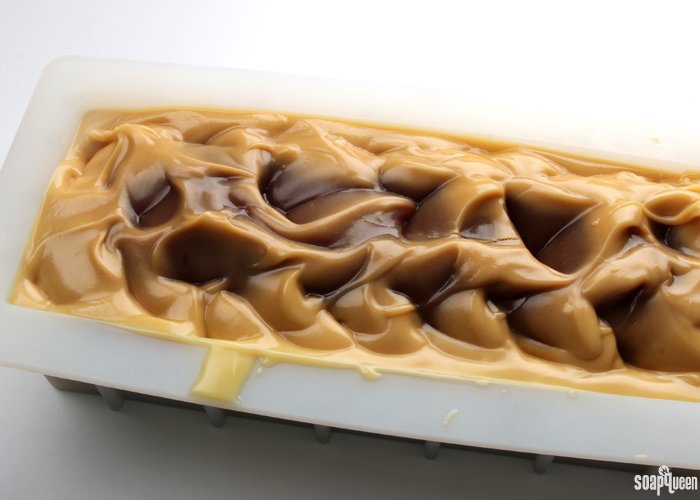
You can choose whether to force gel phase based on your recipe and personal preference.
Forcing gel phase
There are a few reasons you may want to gel soap:
- You want vibrant colors. Gel phase helps the colors pop and it gives the bars a slightly shiny appearance. Learn more about how to color handmade soap here.
- You’re using natural colorants. Without gel phase, they can have a dull appearance and a different hue. For instance, gelled soap colored with madder root powder has a deep red hue. The ungelled version is a muted mauve. See both versions in this post.
- You’re using LabColors. Gel phase makes them brighter and ensures they’re true to color. The Layered Lavender Soap goes from gray to purple after gel phase.
- You’re in a hurry. Because of the higher temperatures, gelled soap hardens and unmolds more quickly. The soap still needs to cure for 4-6 weeks.

Warm temperatures are key to forcing gel phase. Start with your lye and oils around 120-130°F. Once the soap is in the mold, cover it with a cutting board and then a towel or blanket.
If your soapmaking area is cooler, you can place it on a heating pad set to medium. Check it after 30 minutes to make sure it’s not overheating – that can cause volcanoes, heat tunnels, or glycerin rivers. If it’s getting too hot, turn the heating pad off and remove the blanket. If not, leave it on for another 30-60 minutes. Then, turn the heating pad off but leave the soap on it overnight. Learn more about how to insulate soap here.
Preventing gel phase
Here’s why you might want to prevent it:
- You prefer matte soap. Ungelled bars look creamy and have pastel colors that some makers love.
- You’re making cold process soap with milk. It can scorch if it gets too hot, which causes discoloration and an unpleasant smell. That can also happen with alternative liquids like coffee, wine, tea, etc.
- The same goes for soap made with additives like fruit or honey. We recommend keeping the temperatures low to prevent scorching.
- You’re working with soap frosting. If it gets too hot it may not hold its shape.
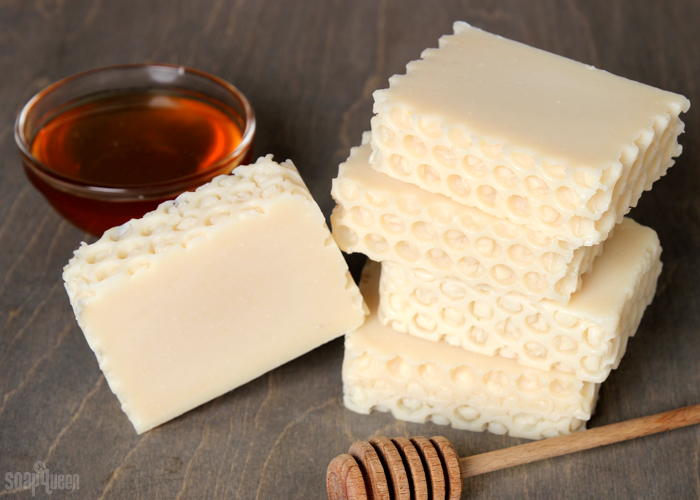 This Pure Honey Soap is kept cold to prevent scorching.
This Pure Honey Soap is kept cold to prevent scorching.
To keep your soap cool, start with your lye and oils around 90-100°F. Once it’s in the mold, put it in the fridge or freezer for 24 hours. You can also put the soap in a cool area like a garage or basement and run a fan over it.
The third option is to leave your soap uncovered at room temperature. It may gel or not, depending on oil and lye temperatures and how warm the space is. That can sometimes result in partial gel phase, where one area of the soap (typically the middle) is slightly darker than the rest. Again, that only affects the look of the bars – they’ll still feel great on the skin.
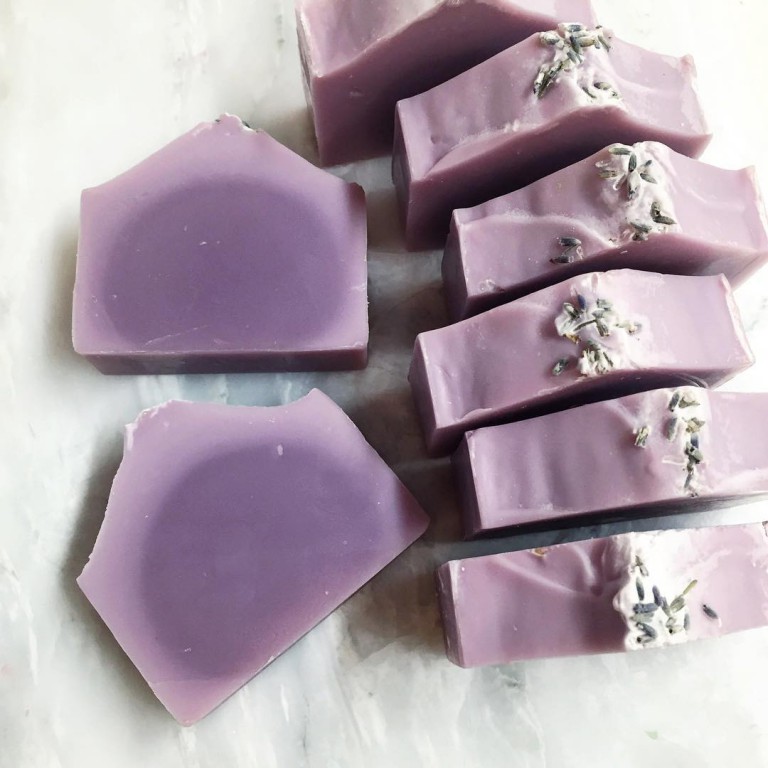 These bars only gelled in the middle, which caused the color difference.
These bars only gelled in the middle, which caused the color difference.
As with everything in soapmaking, the best way to find out what you prefer is to experiment. Try all three methods and then choose your favorite.
This post was updated in February 2019.


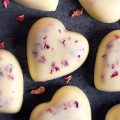
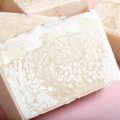
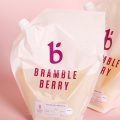
thanks for sharing this amazing info.
Hi,
I was wondering if it is safe to put the soap in a freezer that contains food as wel? I plan on making a milk based soap and to avoid gel phase.
Also, I’m new to soap making and made two so far. The last one turned out nice and creamy white when I poured it in the mold. I tried to force gel phase, but after gelling it got a dull, greenish look, just like the one before :(. I used 49% coconut oil, 35% olive oil, 14% shea butter, 3% castor oil.
Thanks in advance!
Yes, keeping food and soap in the same space should be fine, but we don’t recommend using the mold for both food and soap – it’s best to have a dedicated set of soaping tools. Since your colors aren’t coming out the way you want them to, you may consider skipping gel phase.
Out of curiosity: what is the highest temperature that a soap amounts to during the gel phase? It would be nice to know, but I cannot measure the temperature of the soap once it is solid – I don’t have the tools… Does anybody know the answer? 🙂
Oops, I just saw that it is right at the beginning of the post… 180°F ! Sorry about that, I think I should go take a nap… 😀
No worries! I’m glad you found the answer.
I ONLY make goat milk soap and my soap goes through gel phase EVERY time without scorching or volcanoes. Why do people think that you can’t let your soap go through gel phase just because you use milk??
Temperature can be very difficult to control, especially for newer soapers. It’s easier to simply skip gel phase when you’re working with milk, since it’s already known to cause temperature problems. It sounds like you have your recipe dialed in though, nice job!
Hi! I have an unusual gelling problem and I can’t seem to find a reason. I have a high olive oil % CP soap recipe and I use a 33% lye concentration. I always check the temperatures and mix the lye and water at around 110-120°F. I use a wooden loaf mold with a lid and silicone liners.
The soap heats up nice and gels, but the gel never reaches the edges. So the edges are always a little (well, sometimes A LOT) lighter than the inside. It doesn’t really look like a partial gel. Have you experienced something like that and do you have any ideas why the edges wouldn’t gel? Thank you so much in advance!
Hi Marcy!
It sounds a bit like partial gel phase! Partial gel phase can look like a ring in the middle of the soap, or extend out a bit further and leave just the edges uncolored. It happens when the soap gets warm, but not quite warm enough for full gel phase. To gel the entire loaf, I would recommend wrapping the mold in a towel or blanket. That will heat it up nicely and force the entire loaf to gel. You can also pop the soap on a heating pad for 20 minutes on medium, then shut the pad off and leave it on there overnight. 🙂
-Kelsey with Bramble Berry
Hi 🙂 I am a newbie to soaping. I keep a consistent recipe for all of my soaps: different oils (olive, sunflower, sweet almond, coconut..) and butters (shea butter, cocoa butter…) & I add sugar for extra lather. I do natural unscented and non colored soap but when I do add color and fragrance I use natural clays for color. After i finish mixing the batch I pour the soap & stick it immediately into the fridge for 24-48 hours, then I pull it out to cut. The problem I am having is that when I cut my soap is always partially gelled :(. I don’t really have a preference on whether it gels or not. I just want it to complete the process either way. I sell my soaps so I do not like the partial gel look because I want my soaps to have a consistent look for the most part. I need help 🙁 I thought I was doing everything correctly but I get very discouraged when I cut my soap only to find it has partially gelled. Is there any way to prevent that?
Thank you for any advice you have 🙂
Oh I forgot to mention. I use the silicone loaf soap mold w/ the metal tray 🙂
Hi Devin!
Thank you so much for your detailed recipe, that’s really helpful for me!
I think the sugar is causing the partial gel phase. As your recipe saponifies, the sugar can heat up. So, even in the fridge, you can get that partial gel. There are several ways to keep it cool and prevent that gel phase!
Instead of the fridge, I would recommend popping it in the freezer. That extra cold environment will help keep the soap cool. You can also soap at lower temperatures (around 100F) to keep the batch cool.
You can also reduce the amount of sugar slightly. We usually recommend about 1 tsp. of sugar per pound of soap. Read more about working with sugar here: https://www.soapqueen.com/bath-and-body-tutorials/tips-and-tricks/adding-honey-to-cold-process-soap-tips-tricks-recipe/
For even more lather, you can add castor oil! We recommend it ad 2-5% in the recipe for great bubbles. 🙂
Read more about castor oil here: https://www.soapqueen.com/bath-and-body-tutorials/tips-and-tricks/sunday-night-spotlight-castor-oil/
-Kelsey with Bramble Berry
Hi! I am wondering what a heating pad is? I live in Scotland and the only thing I can find online are for cats or pillows. Is this correct? And if they have temperature settings which is best? Thanks in advance.
Hi Ashley!
Heating pads are flat pads that you can plug into the wall. They are covered with a cloth, and typically have settings of low, medium and high. You can use them on your back or other areas for tired muscles, or to warm and area of your body like your feet. People also use them to keep their cats nice and warm! Amazon has lots of options: http://www.amazon.com/s/ref=nb_sb_noss_1?url=search-alias%3Daps&field-keywords=heating+pads
We love to use them for soap because it keeps the soap warm and encourages gel phase. We have a couple in our Soap Lab. We like to set them to medium and place the soap on for 20 minutes. After 20 minutes, we turn it off and let the soap stay on the pad overnight. If you don’t have a heating pad, you can keep the soap warm with a towel or blanket and place it in a warm room like the kitchen. 🙂
-Kelsey with Bramble Berry
Hi. Can you put in a oven to force gel? Heat it to low est setting. Set soap in on a pan? Shut oven off? Crack door? Leave in over night? Thanks so mucb!
Hi Angela!
You can! That is called the Cold Process Oven Process method. It forces gel phase and makes the colors nice and bright. 🙂
Learn how to CPOP soap here: https://www.soapqueen.com/bath-and-body-tutorials/cold-process-soap/hot-process-series-cpop-swirls/
-Kelsey with Bramble Berry
I noticed that in the new Pure Soapmaking, soap made with tomato paste and goat milk is NOT put into the freezer. How come?
Hi Elena!
For the Layered Tomato Swirl Bars on page 126, we found the red color from the tomato paste was a bit more vibrant when left at room temperature. That’s why we didn’t pop that one in the fridge afterward. 🙂
For the Goat Milk Sunset Burst Bars on page 211, we added a small amount of goat milk at trace and didn’t see any discoloration in our tests when left at room temperature. If you like, you can pop that one in the fridge or freezer for 5-24 hours. We found it worked just fine at room temperature!
-Kelsey with Bramble Berry
How often should you check on cp soap during the insulation stage and how do you know if it is overheating or in danger of doing so? Is uncovering it to check on it something that will affect the end result. I live in Scotland so achieving anything but partial gel is almost impossible (especially in winter!) Any advice appreciated. Thanks, Lizzie
Hi Lizzie!
Because you’re living in a colder area, I would recommend checking the soap once or twice during the first 4 hours. If the soap is overheating, it may crack or start to volcano. If you notice those signs, you can remove the towel or turn of your heating pad.
If it looks fine (solid or with some gel phase), you can leave it for the next 24 hours. You can peek maybe one more time, but not too much – checking too much can cause the soap to cool down. It’s a lot like opening the oven too much when you’re cooking (which I am very guilty of). 🙂
-Kelsey with Bramble Berry
Thanks for taking the time to reply! I really appreciate it! Lizzie
You’re welcome Lizzie! 🙂
-Kelsey with Bramble Berry
I am more familiar with the hp soaps and I made a shaving soap with buttermilk cold process. My first problem was I think my lye/buttermilk solution was too cold to pour into oils, second it was slimy and greasy feeling when I molded it. Now about 20 hours after molding it has not completed the gel phase, do I need to rebatch or leave it as it is or pitch it? It is hard, i did not put any color in it since it has bentonite clay. I also added 1/2 oz lavender eo. Please help I hope its not ruined!!!
Hi Sarah!
I would recommend letting it sit for a couple more days! Milk adds extra fat to the soap, so it makes it a bit softer. As the soap sits in the mold, it should harden enough to cut and cure.
Let me know how that soap is after about a week! If you notice that it’s still soft or separating, you can try rebatching it! 🙂
How to Rebatch Soap: http://www.soapqueen.com/bath-and-body-tutorials/cold-process-soap/soap-queen-tv-presents-how-to-make-rebatch-soap-2/
-Kelsey with Bramble Berry
Hi. Great article. But, I just need some clarification. I understand that when using fruit/puree in your soap recipe, you would not want the soap to go through the gel phase because it may scorch the sugars.
Why would you need to place the soap mold on a heating pad for 20 to 30 minutes to gel? I thought that the gel phase happens automatically because of the saponification process.
After I pour my soap in the mold, I just cover it for 24 hours before unmolding the soap, and everything is fine.
Hi Connie!
That is correct – when using products that contain sugar you want to keep your soap cooler. That will prevent the sugars from scorching, which can overheat your soap. Read more about that in this post on using honey: http://www.soapqueen.com/bath-and-body-tutorials/tips-and-tricks/adding-honey-to-cold-process-soap-tips-tricks-recipe/
As for gel phase, sometimes it happens and sometimes it doesn’t! Either way, your soap will turn into soap. Gel phase isn’t necessary to the saponification process, but it does speed it up a bit.
If you’re soaping at higher temperatures in the warm summer, gel phase may happen even if you leave the soap at room temperature. If your house is on the colder side, you can cover it to force gel phase. To ensure a nice hot gel phase, you can place the soap on a heating pad.
This post talks more about the factors that contribute to gel phase and is really helpful: http://www.soapqueen.com/bath-and-body-tutorials/tips-and-tricks/when-to-insulate-handmade-soap/
It sounds like your storage method is working great! Once you find a method that works for you, you can stick to that one. Whether or not to gel is definitely personal preference. 🙂
-Kelsey with Bramble Berry
I am a learning soaper. I am on about my 15th or so batch of 8lbs. I had a new recipe that I made, simple INS of 165, iodine good, sat:unsat ratio of only a 2 spread. But my inexperience left me worried and discourage when it started to gell. I Super Fatted it at 20 per cent so I would have the soap/lotion bar effect. I thought the gelling was a problem. I left it in the molds for 2 days uncovered, except pieces of cardboard on top. Discouraged I cut it. To my surprise it looked good. After 2 days of drying it looks normal, as you said just a little translucent. I scented it with 3 oz of rose essence and one ounce of mandarin orange, which gave it a more fresh picked rose smell. Thanks to you advice I can stop worrying about my new recipe. Just one question how and what do you do about the little 1inch cracks, I end up with 1 to 3 of them per log and it . (I used my finger to squish fill in the cracks any advice?)
Hi Donna!
You’re welcome! So glad that soap turned out well. The fragrance combination smells amazing. 🙂
Cracking can happen for several reasons, including heat or a high percentage of butters. Because your soap gelled, it may be getting hot enough to form those cracks on top. To prevent that, you can pop your soap in the fridge or freezer for 5-24 hours. That will keep it nice and cool, which helps prevent gel phase and any cracking due to heat.
Read more about gel phase in this post: http://www.soapqueen.com/bath-and-body-tutorials/tips-and-tricks/gel-phase/
Also, if you have more than 15% butter (cocoa, mango, shea) in your recipe, you may try reducing those. We have found that more than 15% butter can make the soap a little brittle, which causes the cracking as well. 🙂
Read more about common oils and butters and what percentages we recommend them at here: http://www.soapqueen.com/bath-and-body-tutorials/tips-and-tricks/free-beginners-guide-to-soapmaking-common-soapmaking-oils/
-Kelsey with Bramble Berry
Hey I made a batch of Lemongrass soap no colors just Lemongrass herbs and essential oil’s 1/5 oz of lemongrass essential oils per 10 pound batch of soap, poured in the 18 bar mold from Bramble Berry, put the lid on and one towel, after 12 hours it is CLEAR, like it is in the gell stage still, I have used this mold a million time covering it, and this has never happened, does it need more time to complete gel stage or is it going to stay this way, looks kinda cool but I wanted the pale yellow color it started out with, does it need to sit longer ?
Hi Jackie!
It sounds like that soap is still going through gel phase! If the soap is nice and hot, it can gel for up to 24 hours after it’s made. That soap should return to a solid color soon. I would recommend letting it sit for 3-4 days in the mold, then taking those bars out. 🙂
-Kelsey with Bramble Berry
My first ever cold process batch I accidentally discovered gel phasing and I actually prefer it. I think mine went through the gel phase because I accidentally overheated my oils. I had to let them hang out in the fridge to cool off before adding my lye solution (it was really way too hot like 180 degrees!). After I got the right trace, I poured the soap in my mold, added my color swirls and put the top on my wood mold. It went through the gel phase and the bars are gorgeous! They have a nice shine and feel to them and they don’t have that dry look like some soaps do.
Hi Kristine!
That’s awesome, so glad to hear your first batch turned out gorgeous! I remember when I first saw gel phase, I thought I did something wrong. It does look a little strange at first. Now, I’m with you – I prefer the shiny look of gelled soap. 🙂
-Kelsey with Bramble Berry
Hi
Thanks for the recipe.
Am a beginner and loving your recipe
You’re very welcome! Glad you enjoy it. 🙂
-Kelsey with Bramble Berry
Hi, you said to leave the soap on a hot pad 20-30 min in order to reach the gelled phase, but I come from a tropical country with temperature above 30C all year round so it’s hard to get a hot pad here. Can i just cover my soap with a few layer of towels, will it reach the be completely gelled? TQ
Hi Rachael!
That’s a great question! If you’re living in a hot climate, you may not need a hot pad. In fact, you may not even need towels! Soaping at higher temperatures and letting the soap sit in a hot room uncovered may be enough to force the soap through gel phase.
I would recommend doing a little bit of testing. After your soap is in the mold, you can cover it with towels. Then, check the soap after an hour or so. If you notice it seems to be seeping or is very hot to the touch, you may want to take the towels off. It may take a bit of experimenting to find the perfect storage method for you. 🙂
Read more about that in the When to Insulate Handmade Soap post: http://www.soapqueen.com/bath-and-body-tutorials/tips-and-tricks/when-to-insulate-handmade-soap/
-Kelsey with Bramble Berry
I am a newbie to cold process soap making. My specialty was melt and pour due to the lye and a curious elderly parent who picks up things and drink without knowing its contents.
Thanks for this information. I will surely try this process asap.
You’re very welcome Denise! Cold process soap is a lot of fun to make. If you have any questions about the process let us know. 🙂
-Kelsey with Bramble Berry
I just made a batch of soap and it completely gelled, which is fine, but how long will it take to harden, it is right now 24 hours later and very soft, I do not think I can unmold it as it is. It much too soft. Also, should I keep it covered?
Hi Gabriela!
It depends on your recipe! Typically, soap needs 3-5 days to harden and unmold. However, if you have a recipe with more soft oils, that can be even longer. I would recommend letting your soap sit uncovered for another 3-5 days. If it’s still soft, give it another day or two. 🙂
To speed that process up, you can add 1 tsp. of sodium lactate per pound of oils to your cooled lye water. Read more in the Sunday Night Spotlight: Sodium Lactate: http://www.soapqueen.com/bramble-berry-news/sunday-night-spotlight-sodium-lactate/
-Kelsey with Bramble Berry
Great article, BB friends. With the exception of milk or sugar soaps, I always gel my soaps. I think soap looks great gelled or ungelled however, it ruins my day to find a beautiful loaf has partially gelled. For me, it ruins the aesthetic appeal of the product and I won’t sell it. That is the main reason I force gel every loaf, if possible. Going for a non-gelled soap is way more stressful for me because I’ve had loaves partially gel even in the freezer before they had a chance to cool down. Another interesting thing is that I always soap below 100 degrees and yet, after insulation, I always get a good, complete gel. I don’t understand it but for some reason, it works!
Thanks again for the great articles, you guys!
Hi Carrie!
So glad you like the article! 🙂
We typically gel all our soaps as well. I just love the bright colors and slightly shiny look! Also, I agree with you – I like it completely gelled.
-Kelsey with Bramble Berry
I started out soaping hot process, but now, I am cold processing. I’m still a little confused about the gel phase. I don’t have a heating pad, so is there something else I can use as a substitute? Also, my first batch I made, I gelled, and it gelled all the way through, but the loaf had a crack down the middle of the top. I was told it was because I soaped too hot. I soaped at about 110 degrees. I guess my question is: since I want the gel phase to be complete; but not have that crack at the top, should I leave the soap covered for 24 hours, and soap at a little lower temp? Thank you.
Hi JoAnne!
If you don’t have a heating pad, you can pop a lid on the soap (cardboard or a cutting board works well). Then, cover it with a blanket or towel. That will keep the soap nice and warm. 🙂
Also, that is correct – if the soap gets too hot, it can crack. This is especially the case if your soap has a higher content of butters. Butters can cause the soap to crack and feel brittle if they are used at more than 15%. Read more about that in the Free Beginner’s Guide to Soapmaking: Common Soapmaking Oils: http://www.soapqueen.com/bath-and-body-tutorials/tips-and-tricks/free-beginners-guide-to-soapmaking-common-soapmaking-oils/
Whether or not you insulate your soap depends on a number of factors. For instance, if your house is very warm during the summer months, it may not need to be insulated at all! It will take a bit of practice to find out exactly which method works for you.
To prevent cracking, I would recommend decreasing the amount of butter in your soap if you use any. Then, if your house is cooler, you can cover the soap with a towel. If it’s warmer, you can just leave the soap at room temperature. The warm room will help promote gel phase.
Read more about when to insulate your soap in this post: http://www.soapqueen.com/bath-and-body-tutorials/tips-and-tricks/when-to-insulate-handmade-soap/
Hope that helps! If you have any questions let me know. 🙂
-Kelsey with Bramble Berry
Thanks for the terrific article! Although I’ve read most of the books recommended by Anne Marie, info over load has afforded me to forget or gloss over a bunch of stuff. Case and point: gel phase. I knew about it, read it in the book, watched it on YouTube and had no idea what it meant. Until now. Espesh, since it happened to me on my second rodeo with soap.
My first batch didn’t gel at all (or I didn’t notice) in the 12 rectangle mold. But today’s batch was hot as heck and gelled super quick in the loaf mold. I did use two different recipes, first one tried, true, from the book… Second, an experimentation I came up with (fingers crossed it’ll go as anticipated). I didn’t use any color since I’m still wobbly on how soaping works, but I did use fragrance. I imagine that the two different FO could be the reason as to one gelling and one not. Also, do some oils cause gelling more than others? I used more variety of oils in batch 2, maybe got a little too fancy for my newbie skills, but I feel like I soaped higher temps with batch 1 that didn’t gel than batch 2. Any insight on this for my soap notebook?
Hi Jes!
So glad you like the article!
Whether or not your soap goes through gel phase depends on a number of factors, including the temperature you soap at and the mold you use. For instance, it can be a little more tricky to get your soap to gel in the 12 Cavity Rectangle Silicone Mold. This is because the soap is poured into individual cavities, which causes it to cool more quickly than if it was in a big wood mold.
If you want that soap to go through gel phase, it helps to soap warmer (around 120-130F). Then, once your soap is in the mold, you can put it on a heating pad or cover it with a towel. That helps the soap stay insulated, which will warm it up and make it go through gel phase. 🙂
-Kelsey with Bramble Berry
12 Cavity Rectangle Silicone Mold: https://www.brambleberry.com/12-Cavity-Rectangle-Silicone-Mold-P5536.aspx
I’m confused…all of the other soaps have gelled when I put them in their box wrapped up in blankets…I made a soap tonight, boxed and insulated it, and it is not going through gel phase…does this sometimes happen? My other soap began getting hot before they were even insulated…I’m wondering if it;s going to be ok…I calculated my recipe correctly.
Hi Tammy!
Whether or not your soap goes through gel phase can depend on a number of factors, including how warm it is in your house and the temperatures that you’re soaping at. If you want a nice hot gel phase, it helps to soap higher, around 130F. That way the soap is hotter going into your mold and will be more likely to go through gel phase.
Also, putting your mold on a heating pad set at low to medium heat for about 20-30 minutes helps as well. 🙂
The good news is your soap will be just fine! Gel phase is purely aesthetic. It gives the soap a slightly shiny look and helps the colors pop, but won’t affect the final bar of soap.
-Kelsey with Bramble Berry
I use small’ish individual shaped molds. 1/3 cup by volume. Would the same gel / not gel rules apply as they do when using a loaf mold? Or because of the size is gelling not possible? Or is it still possible with a heating pad? If using a heating pad would you still leave it on for 20-30 minutes?
Sorry for the run-on question.
Your assistance is appreciated.
I want my soap to Gel
How can I be guaranteed to get my soap into gel phase without heating pads?
Every where I read says soap warmer- warmer is not a very specific temperature.
Hi D.J.!
Gel phase can happen in any size mold as long as the soap gets hot enough. 🙂
To help your soap go through gel phase, you can soap around 130 degrees F. Keep in mind your soap will start to set up a little faster.
Also, if you don’t want to use heating pads, you can put a piece of cardboard over your mold and wrap it with a towel.
-Kelsey with Bramble Berry
Hi,
Thanks for this great post. I am new to soap making & have read different things regarding what to do with your CP soap right after pouring it into the mold. This is the first time I see you can pop it in the freezer to totally avoid the gel phase. But I thought you had to keep it warm to further the saponification process.
Thanks so much for your insight!
Hi Gen!
I’m so glad you found this post helpful! 🙂
-Kelsey with Bramble Berry
Hi there guys, can anyone help me pleeeease with this gelling, business??
i tried soaping at room temperatures and that was fine as i wanted to avoid gel phase, placed my soap in the freezer overnight then removed in the morning. The soap came out looking frozen but great! Left it on the table to thaw out, only to come home and find my soap heated up and mushy and crumbly.. It didn’t work, where did i go wrong? I am now going to attempt to save this batch by hp process..,first time avoiding gel phase failure
Hi Katherine!
I’d love to help you troubleshoot! Would you mind telling me a bit more about your recipe? The reason I ask is certain oils and additives can cause the soap to heat up or crumble. Thanks so much. 🙂
-Kelsey with Bramble Berry
I’m gellin’ like a felon.
Haha, oh me too! 🙂
-Amanda with Bramble Berry
I was told that gelling will affect your fragrances and keeping the soap cooler and not allowing it to gel will keep your fragrance stronger smelling and longer lasting in your bar. Reasoning being that since many fragrances have a lower flashpoint when your soap is heating up to gel it is actually burning off some of that fragrance.
Has anyone else found that to be true? I don’t know because I never gel..I only make milk soaps.
Hi Amber!
I have heard this as well, but I have never actually noticed a huge difference in my soap that has been gelled, vs. soap that has not. If you want to be on the safe side, I would recommend adding a little more fragrance oil to the soap you plan on gelling 🙂
-Amanda with Bramble Berry
Hello! Thanks for this information. I’ve been making goat milk soap for a while now, and I’ve achieved gel in some batches and soaped even colder and avoided gel in others. I actually like soaping at a pretty cool temp even when I plan for gel (90 degrees for oils and 75 degrees for lye/soap mixture), which I think avoids scorching the milk. I always use frozen milk and keep it in an ice bath when I add lye.(I’ve only scorched the milk once, at a higher temp, and I could really tell the difference.) But, then, after I combine the oils and pour the soap, I insulate the molds when I’m trying to gel, and I actually really like the way this turns out. It doesn’t smell bad at all (smells great while curing, even in first 24 hours). And the bars are harder and I like the appearance. Is this OK? Is it possible the milk is scorching after the soap is in the molds? I think if it were, it would smell funky. The cured soap still feels incredibly moisturizing and milky. Thanks for any advice!
Hi Shelley!
We have found that in general, when you scorch milk soap…you know it! Haha. That’s the great thing about soaping too, if you are happy with how your soap turns out, then I consider that a success! It sounds like your soap is just fine 🙂 It also sounds like you have found a great technique for your milk soap!
-Amanda with Bramble Berry
So, what happens when the milk is scorched? Is there a different look? I made my first milk soap the other day. I put it in the freezer for 24 hrs., sat it out for another 24 hours and it looks ready to unmold.
Hi Joy!
Scorched milk can discolor the soap, and also has an unpleasant smell. It’s still totally fine to use and that smell should fade after awhile. It’s just an aesthetic thing. 🙂
Read more in the How to Add Lye to Milk for Cold Process Soap post: http://www.soapqueen.com/bath-and-body-tutorials/tips-and-tricks/how-to-add-lye-to-milk-for-cold-process-soap/
Also, congratulations on your first milk soap! If it’s firm to the touch and doesn’t stick to the mold, you can definitely pop it out and cut it. 🙂
-Kelsey with Bramble Berry
I love gelling all my soaps!
Hi Kenna!
We love gelling many of our soaps as well, it makes the colors so vibrant and fun! 🙂
-Amanda with Bramble Berry
“…Milk soaps are best soaped cold (very cold), or else you risk scorching the milk proteins and sugars…”
How cold? Is it possible to be too cold?
I put my goat’s milk soap in the freezer for at least 24 hours before unmolding. And use very cold milk (almost frozen) to mix with the lye while making it. Lye will thaw the milk and it won’t get too hot to scorch it.
I should have been more clear… I mean how cool/cold when the lye mixture is incorporated into the oil mixture.
Hi Susan!
Good question. We actually like to freeze our goat milk first, and then add the lye to the frozen milk. You may find this video on how to make Goat Milk Soap helpful! 🙂
Goat Milk Soap Tutorial on Soap Queen Tv:
http://www.soapqueen.com/bath-and-body-tutorials/cold-process-soap/goat-milk-soap-tutorial-on-soap-queen-tv/
-Amanda with Bramble Berry
Thank you, Amanda. I do freeze my goat milk before adding the lye. My question relates to my understanding of what Anne-Marie said, that “…Milk soaps are best soaped cold (very cold), or else you risk scorching the milk proteins and sugars…” Unless I’m mistaken, I believe she was referencing the temperatures of the lye/milk mixture and oil mixture when they are combined. So my question is, how cold, and is it possible to be too cold? Thanks!
Hi Susan,
For the oils, you can go as low as 75 – 80 degrees. If you’re using a coconut oil recipe it will probably start to set up at these temps, but thats okay! If you’re using olive oil, you can go even colder. The lye water should be around room temperature, so anywhere between 65 – 70 🙂
Hi,
Thank you for this post. I have a question to gel or not to gel 🙂 soap made with no milk, no purees, just water for lye solution but with sugar added for extra bubbles? What is the best approach here?
Hi Ewelina!
Good question! When you add sugar to the lye water, your soap will have the tendency to want to gel because of the extra sugars. If this is something you want to avoid, I would recommend soaping cold, and placing your soap in the fridge or freezer to avoid gelling. If you’d prefer your soap to gel, I would recommend insulating for just a few minutes, and once you can feel some heat coming from the soap, remove the insulation 🙂
-Amanda with Bramble Berry
Great article! It’s really helpful to gather this info into one place, and it’s a great explanation of why or why not to encourage gel phase.
I frequently use Lab Colors, so I usually encourage gel phase. But the first time I made goat milk soap, I didn’t realize that you have to be careful to avoid gel phase – I carefully controlled the temperature at the beginning, but I allowed my loaf to get too warm after pouring, and I ended up with a near volcano! I won’t make that mistake again!
Another thing that can happen when you encourage gel phase is the presence of glycerin rivers, which I got when I encouraged gel phase with the Avocado Moisturizing bars. As y’all wrote a couple of weeks ago, the rivers don’t ruin your soap, but they add an interesting “leathery” appearance.
Hi Elizabeth!
Oh no! It usually only takes one soap volcano to avoid those exact methods again, haha :). Oh good point about the glycerin rivers! Thanks for bringing that up 🙂
-Amanda with Bramble Berry
I have a question about your rebatch soap available for purchase. I know that you can’t really gel milk soaps successfully, so how does that work when using Brambleberry goat milk rebatch soap? Doesn’t that have to be heated (melted) to use it? How does that work with the goat milk? Just wondering.
Hi Jaimie!
Good question. That soap has already gone through the saponification process. When you make it for rebatch, you are melting it down with additional liquids. So while it does get hot, and you need to avoid burning the soap, it will not go through gel phase again. I hope this helps 🙂
-Amanda with Bramble Berry
This is a really interesting post. Thanks for sharing
Hi Darlene!
I’m so glad you enjoyed this post 🙂
-Amanda with Bramble Berry
How does gel vs non-gelled soap fare when doing rebatching? Does it makes any difference at all?
Hi Dale!
When making rebatch soap, your soap will not go through gel phase because it has already gone through the saponification process. With rebatching, you are just remelting the soap down. While doing this, it will get hot again, but won’t go through gel phase because it will immediately begin to cool once it is removed from the heat source 🙂
-Amanda with Bramble Berry
Very nice explanation of gel phase. I thought however that a soap could still go thru a gell phase after saponification if the temperature & moisture content were above the Kraft tempt. Above this temperature at a specific moisture a liquid exists (gel) and below a mixture of liquid crystals, solid crystals,&/or water. Great explanation of this on this reference; Raut, Janhavi S.; Naik, Vijay M.; Siddhant, Singhal; Juvekar, Vinay A. Soap: The Polymorphic Genie of Hierarchically Structured Soft condensed-Matter Products; Ind. Eng. Chem. Res. 2008, 47, 6347
I hadn’t heard that before! Thanks for the info 🙂
Very nice explanation of gel phase. I thought however that a soap could still go thru a gell phase after saponification if the temperature & moisture content were above the Kraft tempt. Above this temperature & at a specific moisture a liquid crystal exists (gel) and below a mixture of liquid crystals, solid crystals,&/or water. Great explanation of this on this reference; Raut, Janhavi S.; Naik, Vijay M.; Siddhant, Singhal; Juvekar, Vinay A. Soap: The Polymorphic Genie of Hierarchically Structured Soft condensed-Matter Products; Ind. Eng. Chem. Res. 2008, 47, 6347
I am a newbie when it comes to soaping but this knowledge will definitely be used for the next batch of soap that I make. 🙂 I wish I would have know this before my last batch of soap as I would have preferred it to be gelled.
Hi Sarah!
I’m glad you found this post helpful. Soaping is definitely a learning process, and you’ll learn something new with each and every batch 🙂
-Amanda with Bramble Berry